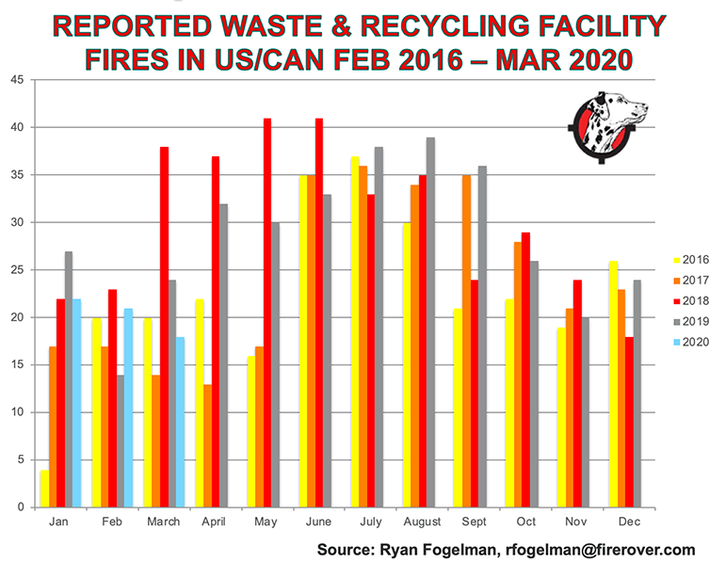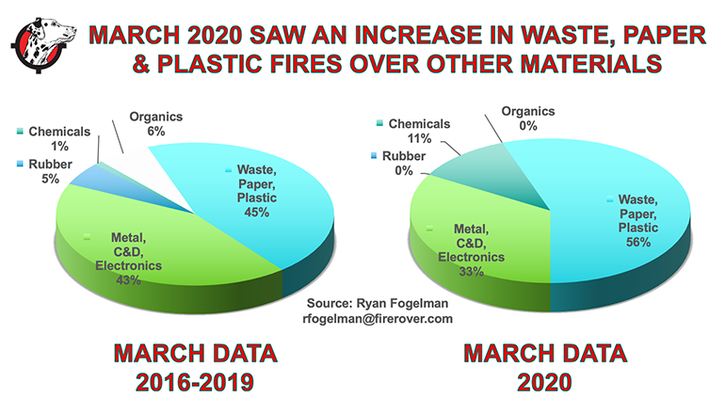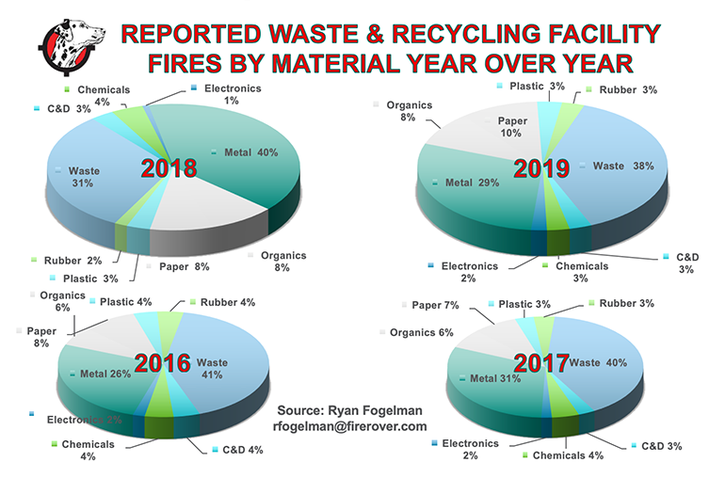March 2020 Fire Report: COVID-19’s Effect on Waste, Recycling Facility Fires
This month will go down in the history books as the beginning of the U.S. and Canadian fight against COVID-19.

What a month it has been. History tells us that March is supposed to be in like a lion and out like a lamb. The complete inverse has been true for March 2020. This month will go down in the history books as the beginning of the U.S. and Canadian fight against COVID-19.
We began the month with our employment rate low, our economy churning and the stock market at all-time highs. Contrast that to April, as we walk into more than 4 million-plus unemployment applications, the market down 30 to 40 percent and the economy facing its worst recession threat since the financial crisis. The most concerning part is that experts are at each other’s throats as they debate and philosophize where they believe we are headed as we walk into the heart of the election year.
In March, we saw 18 fire incidents at waste and recycling facilities. That is not a bad number on its face, but my belief is that there are some unique issues caused by the effects of the COVID-19 fight, especially on the waste side of the industry. In this article, I will thoroughly address those specifics.

During the past 12 months, the waste and recycling industry has experienced 339 reported facility fires in the U.S. and Canada. Additionally, we incurred 50 reported injuries and four deaths that can either be directly or indirectly attributed to these fire incidents. Based on reasonable assumptions, we can extrapolate that 1,800-plus facility fires have occurred during that time, which, based on the number of facilities reported by the Environmental Research & Education Foundation (EREF), is more 40 percent of the industry. I define “reported facility fires” as any fire that has been reported by the media that occurs at a waste or recycling facility in the U.S. and Canada. Typically, the fires that are reported by the media are larger fires that require fire professionals to arrive on scene and where there are affects that the public can witness.
How COVID-19 is Affecting Our Current Waste and Recycling Streams
In March, we only experienced 18 fire incidents. Historically, this number is low, but I believe it is deceiving. There were a number of temporary and full recycling program shutdowns, as well as changes in processes, staffed hours and confusion, that occurred during the initial phase of quarantines.
The fire incidents this month consisted of 10 at waste, paper and plastic facilities, but all of those were waste facility fires. There were no plastic or paper recycling facility fires. In addition, there were six at scrap, construction and demolition and electronics processing facilities and two at chemical recycling facilities.
At Fire Rover, we also have seen an increase in “saves” at our clients’ waste operations, one of which I will share below. Although these numbers are not out of the ordinary on their face, when compared to prior March’s and years past, there is definitely a reason to take a deeper dive.

In the figure above, I broke down the fires by material to compare this March against our experience during March over the past four years. As you can see, the number of waste fires is 56 percent of the total incidences versus 45 percent for the prior years. If you compare the 56 percent to the prior years’ full data in the graph below that was published in the “2019 Annual Waste & Recycling Facility Fire Report,” you can see that waste typically only accounts for about 40 percent of fire incidents.

As one can imagine, it doesn’t typically make sense to break down a month’s data, but in this case, when we have such a high percent of a specific material as compared to the rest, it seems abnormal. When you take into account all of the factors facing the industry, we can definitely make some assumptions.
The Quarantine Effect
So, we need to ask the question: Is there a “Quarantine Effect,” and if so, what does it mean for our industry? Most formal stay-at-home orders have been levied in and around the country over the past two weeks. I live in Ohio, with Mike DeWine as our governor. He was recently touted by the BBC as the “The U.S. governor who saw it coming early.”
“On 5 March, after resistance from organisers, Mr DeWine got a court order to shut down much of the Arnold Sports Festival—an annual event featuring 20,000 athletes from 80 countries, around 60,000 spectators each day, and an expected $53m for Columbus, the state's largest city. … Over the next three weeks, Mr DeWine moved to bar spectators from major sporting events—days before US professional leagues decided to cancel their seasons. He was first in the nation to declare a state-wide school shutdown. He invoked an emergency public health order to postpone Ohio's presidential primary the night before it was scheduled on 17 March.”
Whatever your political beliefs, as of March 31, most governors across the U.S. have followed suit. Most of us knew this was coming, as we were either formally or informally warned by our friends, colleagues, relatives and neighbors. Most of us began to prepare for the worst. We cleaned out every brick-and-mortar grocery, drug and sundry store in the country. After that, we ordered all we could online. In the process, we created a ton of waste that was left at our curbside. It was a Christmas bump from a trash perspective that we see every year.
Then, we moved on to school closures. Our kids were told that they were going to be homeschooled. A number of schools are not going to reopen, so they will be cleaned out during April, months before the traditional May/June timeframe that they drop their school years’ worth of waste into the stream. Keep in mind we are talking about 132,853 K-12 school in the U.S. alone, according to the National Center for Education Statistics. In addition, the lockers will be cleaned out by the schools as opposed to the children bringing these items home. The lockers, as one could imagine, are going to be filled with toys containing lithium-ion batteries, among other hazards.
So, after the shopping and the school closures, we’re stuck with finding things to do at home. Many have opted for the inevitable “spring clean.” But this spring clean is like no other we have seen before.
This spring cleaning season, we are ALL home, and we ALL have more time on our hands. To compound things, there are no activities that get in the way. There are no spring break trips, no kids’ soccer or AAU basketball games, no religious activities, etc., to take us away from the cleaning. We are working from home, so there are no long commutes or happy hours. We clean out our closets, our bedrooms, our basements, our garages and our dreaded attic. We dig out boxes of old electronics, computers, paints, old toys, remote controls, unused chemicals, cleaners and more.
Where does all of this stuff go? We are under a stay-at-home order. We call around to charities, most of which have postponed their pickups indefinitely. We hesitate to sell our stuff on Craigslist or Facebook because we do not want to interact with strangers. There are some drop-offs still open, but we have made recycling harder, and unknowingly leaving the house to recycle might even get you one of those $10,000 tickets we keep hearing about.
Alas, we place all of these items in the steady hands of the heroes who pick up our waste at our curbside. The “essentials” that we in the industry praise as they work on the frontlines of this war because we understand the dangers of the industry during normal times. They take whatever we put out at the curb, including hazards knowingly or unknowing put out by the public. Our waste facilities then start to fill up, as they receive more tonnage and some recycling programs are suspended for the foreseeable future.
The reported fire data that we see above only tells one part of the story. At Fire Rover, we are on the frontline, and we see the “unreported” fires as well, which I do not share in my data. Over the past month, we have seen the number of “saves” steadily increase. Take a look at this video from a fire incident that started in a municipal solid waste pile on a tipping floor at one of our clients’ waste transfer stations. I sped up the video 10 times to save time.
We detected that the fire was deep-seated, so our agent remotely applied our environmentally friendly cooling agent for more than 10 minutes until the fire was under control. We are still unsure what caused the fire, but odds are it was one of the hazards I mentioned above. It is true that every “save,” whether by our system, operational processes or prevention, gets us to the same goal of safety and business continuity. When taken in combination, they show us the true dangerous scope of the issue and the potential consequences.
We Need to Keep Our Focus on Fire Prevention During COVID-19
I am not trying to sound an alarm. I hope that I am wrong about these trends and we will have an April like we did in 2017, where we saw our lowest number of fire incidents ever. But, as increased waste and recycling is placed into curbside bins and deep cleaning trends ensues across the country, with less drop off points, uncertainly labor force and people unable to leave their home, the more fire hazards are going to get into our waste and recycling streams.
I am sure you are all sick of hearing that we are experiencing “unprecedented times” and that we are facing the worst health crisis since the flu pandemic of 1918. We do not know how long these orders will stay in effect or when things will begin to “normalize.” What I do know for sure is that the U.S. waste and recycling industry is a tough industry. Our folks are on the frontlines ensuring our country is safe, sanitary and economically viable.
When it comes to fire risk, we need to stay the course and remain as viligent as ever to keep our facilities safe. This includes doubling down on the path we have been forging for the past five years that consists of best-in-class fire prevention planning, public education on the hazards caused by the lack of following safe recycling rules and investments in innovations and technologies that will keep not only our employees safe but our facilities and our “critical” and “essential” waste and recycling infrastructure running on all cylinders.
Ryan Fogelman, JD/MBA, is vice president of strategic partnerships for Fire Rover. He is focused on bringing innovative safety solutions to market. He has been compiling and publishing the “The Reported Waste & Recycling Facility Fire In The US/CAN” since February 2016 and the “Waste & Recycling Facility Fire Annual Report.” Fogelman speaks regularly on the topic of the scope of fire problems facing the waste and recycling industries, detection solutions, proper fire planning and early-stage fire risk mitigation. Additionally, Fogelman is on the National Fire Protection Association’s Technical Committee for Hazard Materials.
About the Author
You May Also Like




.png?width=300&auto=webp&quality=80&disable=upscale)